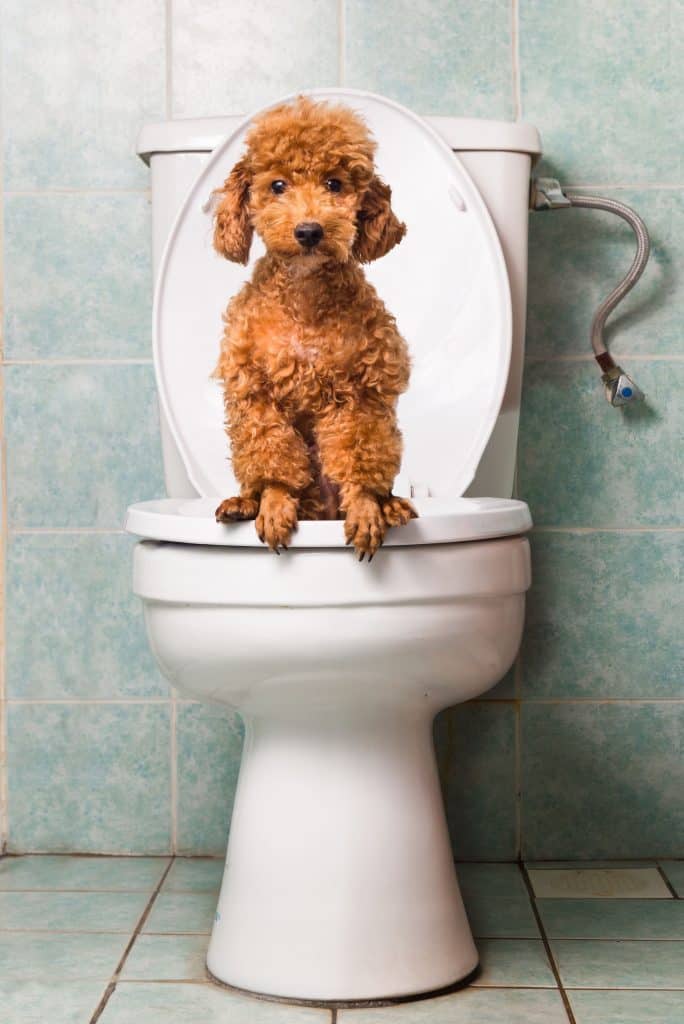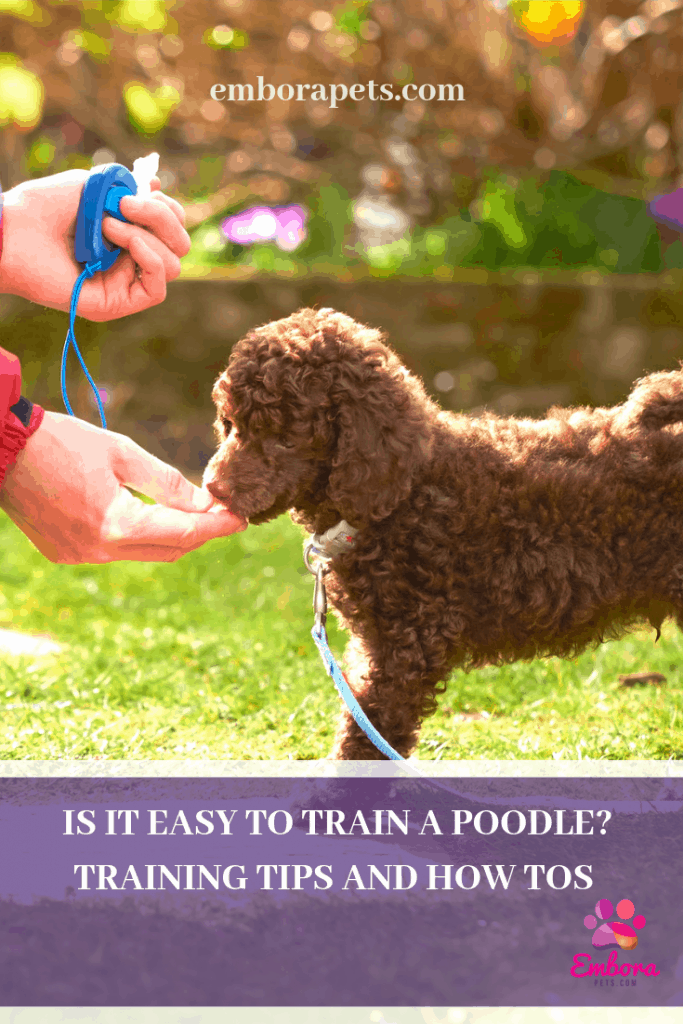How Easy is It to Train a Toy Poodle
Poodles are a very sought-after dog that families love to have. Many people want a dog, but don't always have the time or resources to train one. I was wondering if poodles are easy to train and how to train them, and here is the research I have summarized for you.
Are Poodles Easy to Train?
Poodles are easy to train and are known to be very intelligent animals. Poodles are considered one of the smartest dog breeds. Poodles can learn tricks and commands quickly and easily. They were originally bred to be working dogs, so they are very competent at doing what they are trained to do effectively.
If you are interested in learning training tips for a poodle, why poodles are so easy to train, and if a poodle is right for you, continue reading below.
Basic Training Tips for Your Poodle
When training any dog, the command "sit" is a good place to start. It is an easy command to teach, and it will help the dog be more susceptible to learning more difficult concepts in the future and act as a foundation for other important commands such as "lay down" and "stay."
The fastest and easiest way to start training your poodle is by using treats. Food is a big motivating factor for dogs and will be more effective than verbal praise at first. Treats can eventually be phased out, but are a good place to start.
Here are some good training reward treats from Petco which are good for poodles and most other dogs.
You can buy special training treats at almost any regular pet store that are smaller, and less likely to fill your dog up if you are worried about giving them so many treats. These also leave the dog wanting more so they don't get full off of the treats, or bored of them and stop wanting to train. You can also use baby carrots which are healthier for your dog.
You also want to build trust with your poodle. Trust is very important.
A dog will be much more willing to listen to someone they see as a master or someone that they are safe with, especially if you are working with a poodle that's older, and not a puppy. Older poodles are less willing to learn from someone they don't know.
You can build this trust by spending time outside of training with your poodle, playing with them, or loving them and petting them.
Make sure when you are training your poodle, you don't use fear as a motivator. Like I said before, you want your poodle to trust you and feel safe around you, not fear you.
You may get immediate results by using fear, but in the long run, the dog will be more disobedient when you are not around or try to get away when given the chance.
Patience is key. Even though they feel like members of the family, a poodle is still an animal. Some poodles learn faster, and some learn slower, each dog is different.
Don't get frustrated or discouraged if your poodle isn't picking up a concept right away, it may take some time and that's okay. Just keep working with them, and maybe take a new approach to what you are trying to teach them.
How to Teach Your Poodle to Sit
As I mentioned in the basic training tips, teaching your poodle to sit is a good place to start when beginning training. But how do you teach your poodle to sit?
Sit is one of the easier commands to teach, because it doesn't take much time or effort. One thing you need to remember is repetition and reinforcement.
- The first thing you want to do is get your poodle's attention. You can do this by showing your poodle that you have a treat in your hand, but don't give it to them.
- Once your poodle's attention is on the treat, slowly raise it above their head, causing them to look straight up, and say "sit" or whatever command word you have chosen.
- Naturally, your
dogs vision path will cause them to move into the sitting position. - Once they sit, give them the treat and a lot of love and verbal praise.
- If instead of sitting, they begin to
backup , gently press down on their back end while keeping the treat above their head, and continue to say your command word. - Once they sit, reward them and give them praise.
Continue to do this process about 3 to 5 times, rewarding them each time they do it successfully. Don't overwork the trick, as your poodle could lose interest and not want to do it anymore. End the training session on a good note, and on your terms.
Continue to do this once a day, for however long it takes your p
You can give them a treat every other time they do it, then every three times, until eventually they don't need treats and will just do it by hearing the command.
How to House Train Your Poodle

House training your poodle is going to want to be one of your first priorities, as no one wants their dog to have a messy accident in the house.
House training is a lengthier process than teaching your dog a basic command, because it takes just as much consistency, effort, and commitment from the dog, as it does the owner. It also takes longer for the dog to understand and adjust to than average commands.
The easiest way to begin house training a
Routines will eliminate a lot of confusion with the
After your poodle is finished eating, take him outside and lead them to the spot where you want them to go. You may have to wait outside with them for a couple of minutes. Once they go, give them a small reward, and give them lots of praise. Do this every time until they start going outside and to their spot on their own.
You also need to be aware of the signs that they are about to go to the bathroom and make sure you take them outside before they go in the house. Look for signs such as pacing, circling the house, and sniffing the floor.
Lead them to the same spot you want them to go every time. Consistency is key when training your poodle, you don't want to confuse them with what you want them to do.
Crate training is not advised for poodles, because they grow to be such big dogs. They don't like to be cramped or uncomfortable when going to the bathroom. It can be done but is not the best circumstance for a dog.
How to Teach a Poodle to Stay
Now that your dog has mastered the "Sit" command, "stay" is the next step. Teaching your poodle how to stay is another command that is important for making sure your dog is well-behaved.
- Start off this training by telling your poodle to sit.
- Once they do this, hold your palm out and say "Stay", or whatever command word you have chosen in a slow and steady voice.
- While doing this, take a few steps backward. (Start off small with only one or two steps) and reward your dog if they stay.
- Keep doing this, and gradually increase the steps each time.
This command will usually take a little bit longer for your poodle to learn because it is teaching them self control. It is especially hard for a high-energy dog, like your poodle to sit and stay when they want to keep moving. Just be patient, and don't beat this exercise to death.
Practice a little bit each day until they get it. This may take up to a couple weeks, so don't get discouraged or frustrated if your poodle isn't picking it up right away. Everything takes time.
How to Teach Your Poodle to "Come"
Another important command to teach your poodle is how to come when called. This will help them to stay out of trouble, or prevent them from doing things they aren't supposed to. This is also a good base for other commands or training habits, as it will get your poodle to come straight to you instead of trying to lead them places.
For this training session you will need a collar and a leash for your poodle, and as always, treats.
- First, hook your poodle up to the leash, and get the leash's distance away from them.
- Squat down so you are eye level with the poodle, and say your chosen command, such as their name or a whistle, and simultaneously tug on the leash.
- Once they come to you, give them a treat, and verbal praise.
- Continue to do this until you no longer need to tug on the leash for them to come to you, and will just come by saying your command word.
- Then, in an enclosed and safe area, take your poodle off the leash and have them perform the same task.
- Slowly phase out the use of treats, to just verbal praise.
Do this training exercise for about five minutes a day until they have it perfectly down. As you don't want them to get bored or tired of it. Just the same as when training them to sit, end the training session on a good note, and on your terms.
Be patient as it may take a few days for your dog to even get off the leash. Don't rush them or get mad, if your poodle isn't getting it right away, just keep working with them.
The History of the Poodle
So why are poodles so smart and why are they so easy to train?
Poodles date back to as early as the 15th and 16th centuries. There was a debate on whether the poodle originated in France or in Germany, and although France originally got the credit, it is now said that they originated from Germany because of their name is of German descent.
The poodle was originally bred to be a water retriever and hunting dog. Their coat is water resistant and allowed them to be great swimmers, and they still are.
They were trained to be obedient and committed to their job and the task at hand. They were also expected to be loyal to their master. This can explain why they are so intelligent and easy to train, it is literally in their blood.
Aside from hunters, poodles have been known to do a lot of different jobs. Some of the most common are guide dogs, guard dogs, military dogs, and even as circus performers or wagon pullers.

As history moves on to the late 18th century, the poodle became one of the most sought after pets in Spain. They were known as pampered dogs and became a favorite among the people.
They still continue to be one of the most sought after pets, being in the top ten most registered dog in the United States. Their legacy stays strong.
Is a Poodle Right for You?
Poodles are very popular dogs, they are very intelligent, and in the top 10 most owned dog breeds in the United States. Now that we've gone through how to train a poodle, and you think you could do it, the next question is…
Is a poodle right for you? That depends on what you are looking for.
If you are looking for a family dog:
Poodles make very good family dogs as they are kind, fun-loving, and affectionate. They are very good around children, and even other animals. They aren't aggressive animals and don't shed which is great for families, especially those with allergies. They are one of the most popular dog breeds for families to have.
If you are looking for a guard dog:
While they are not known to be aggressive dogs, they have protective instincts that make them a good guard dog. They are very loyal, and intelligent, making them smart enough to sense danger and protect their owner. They wouldn't make the best guard dog if you are looking to keep people away, but if you want an extra sense of protection a poodle would be a good fit.
If you are looking for a companion:
Poodles would make a good companion dog because, in addition to being loyal, they are also very affectionate. They live to please their master and love attention.
If you are looking for a docile dog:
If you are looking for a docile dog, for a small house or apartment, a poodle probably isn't the best dog, because they are high-energy. While they can be calm, and affectionate and loving, they also need exercise and space to run. They don't do well cooped up in small areas, as they love to get out and play just as much as they love to cuddle.
If you want a dog that doesn't shed:
Poodles are great because not only do they not shed, they are hypoallergenic. Their coat, if kept groomed, is short and curly, and doesn't leave hair on everything. It is a great dog for someone who has allergies because it's coat is hypoallergenic.
If you are looking for a working dog:
Poodles were bred to be working and hunting dogs, and are still used for that today. They are loyal and intelligent, making them easy to train to do a task. Poodles make great working dogs.
If you are looking for a low maintenance dog:
Poodles are moderately low maintenance, as in they don't take a lot of time to train or keep out of trouble. That being said they do need daily exercise and to be groomed every couple of weeks. If you are looking for a dog that just lays around the house doing nothing, a poodle probably isn't the best fit for you.
Are poodles Aggressive? Not necessarily. Poodles are very sweet dogs, and good around people and children. They are known to make good watchdogs because of their mild protective instincts, they are not known to be an aggressive breed, as they are more fun-loving and affectionate.
Are poodles loyal? Poodles have been known to be very loyal to their owners, and are easy to train partly because of this. Poodles want to please who they consider their master. The better you train and trust your dog, the more loyal they will be to their owners.

Are poodles good with other dogs? Poodles are gentle animals and are usually good with other dogs and cats, and get along with them just fine. But, they are much more mischievous when living with other poodles or dogs. It is advised that poodles be the only dog in a family.
raiwalasputhessir.blogspot.com
Source: https://emborapets.com/are-poodles-easy-to-train/